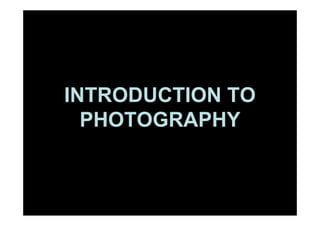
04.controls
- 1. INTRODUCTION TO PHOTOGRAPHY
- 2. CAMERA CONTROLS Aperture, Shutter Speed & ISO
- 3. Aperture The lens opening inside a photographic lens. The size of the opening in a camera lens CONTROLS amount of light passing through onto the sensor inside the camera during the exposure process Aperture is sometimes referred to as the f-number or f-stop and symbolised as f/number (ie - f/1.4, f/5.6, f/8) The LARGER the number, the SMALLER the opening. Therefore an aperture of 5.6 < f/2 Smaller openings let in LESS light
- 4. Aperture The Aperture size is one of the factors affecting DEPTH OF FIELD Depth of Field (DOF) refers to how much of the entire picture is in focus from foreground (front) to background (rear). An image where the the foreground & background are blurred but the area where the camera focuses on is in focus is one with a shallow DOF
- 5. Large aperture causes shallow DOF
- 6. Telephoto lenses (long range lenses) also compresses perspective, giving an illusion of shallow DOF
- 7. Wide angle lenses (shorter focal length) & small aperture causes great DOF where image is sharp throughout
- 8. Using a large aperture & creative focus, you can choose which areas of the image to draw your viewer’s eyes to. In this instance, the viewers’ eyes are naturally drawn to the area in focus (centre)
- 9. In this instance, the viewers’ eyes are naturally drawn to the foreground, which is in focus
- 10. LARGE APERTURE Good for: Separating subject from background such as in portraiture Selective focusing of a small area within photograph When you need to use high shutter speeds Handheld photography in low light (indoors, dawn, dusk) Not good for: Showing entire photograph in focus SMALL APERTURE Good for: When light is extremely bright (e.g. mid-day) When you need to use slow shutter speeds Showing entire photograph in sharp focus (landscape photos) Not good for: Selective focusing of a small area within photograph USE A TRIPOD/SUPPORT WHEN SHUTTER SPEED IS BELOW 1/FOCAL LENGTH OF YOUR LENS
- 11. SHUTTER SPEED The speed in which the camera’s shutter curtain opens and closes. This CONTROLS amount of light passing through the camera body, onto the sensor inside the camera during the exposure process Shutter speed is measured in Seconds or Fractions of Seconds (ie - XX seconds or 1/XXX seconds) The LARGER the fraction number, the FASTER the shutter speed. Therefore 1/250 > 1/60 Faster shutter speeds let in less light.
- 12. SHUTTER SPEED When taking photographs without an artificial light source (ie flash), a faster shutter speed is preferred when you are hand holding your camera. However….. FASTER IS NOT ALWAYS BETTER!
- 13. High shutter speeds allow you to freeze moving objects such as the water.
- 14. Here, using high shutter speed works in showing the plane in focus, but the plane looks suspended in mid air!
- 15. Using slower shutter speeds and a tripod has allowed the capture of passing cars as light streaks in the evening.
- 16. Slower shutter speeds allow you to capture the ambient (available light in an environment) that look natural.
- 17. Panning with a slightly slower shutter speed gives a sense of motion to the car.
- 18. FAST SHUTTER SPEEDS Good for: Freezing moving objects Handheld photography Indoor photography where flash is not allowed but there is sufficient lighting Not good for: Suggesting movement SLOW SHUTTER SPEEDS Good for: Suggesting movement If you have a tripod Lowlight photography with tripod to allow more ambient light in Not good for: Freezing objects
- 19. ISO ISO is the sensitivity of the sensor to light. Normally, when there is low light, we use a high ISO. If there is a lot of light, we use a low ISO. ISO is measured by doubling the initial number. It usually starts at ISO 100, next is ISO 200, ISO 400 and so forth. Higher ISO means the sensor is more sensitive to light.
- 20. ISO When the light is low (night time, low light), we use high ISO. However…. Higher ISO is not always better!
- 21. ISO Selecting a low ISO with tripod allows you to take pictures that are less “noisy”.
- 22. ISO We use high ISO only when there is no support for the camera. Where possible, always use a low ISO to take photographs. Photographs come up sharper & colours are more vibrant.
- 23. Putting it all together Taking a photograph 1. Select an ISO you wish to use - recommend setting between ISO 100 - 400. 2. Focus (half-press on the shutter release button) on the subject and ensure exposure is correct (you will hear a sound that tells you focused is confirmed) 3. Recompose by moving the camera to place your subject where you want (your finger is still half-pressed on the shutter release button). 4. Take the shot by pressing fully on the shutter release button. When composing the shot, ask yourself, “have you fulfilled the basic rules of composition? (rule of thirds, visual elements)?” before you fully press the shutter.
- 24. Putting it all together Taking a photograph Focus confirmed by the red light in viewfinder. In some cameras, the light is green.
- 25. Putting it all together Taking a photograph Exposure - circled in red. + means over exposed (picture will be too bright). - means underexposed (picture will be too dark). You should aim for 0 (correct exposure)
- 26. Putting it all together Taking a photograph Picture will be too bright - OVEREXPOSED Increase the shutter speed or close the aperture. Picture will be too dark - UNDEREXPOSED Lower the shutter speed or open the aperture. Picture will be properly exposed Take the shot!
- 27. The End